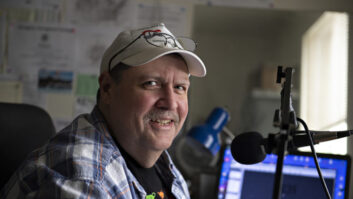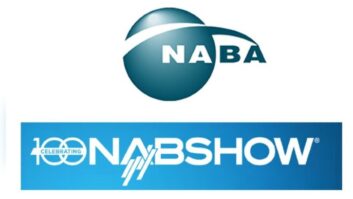WASHINGTON The golden age of AM radio it’s not. From clear-channel powerhouses to small rural stations that still feature a grain report, the news for owners on the U.S. AM radio band is fairly grim.
The economic recession has exerted a severe financial toll on many AM licensees, in a few cases forcing owners to take the drastic step of turning their stations off when they can’t pay their bills and leading others to trim staff to minimum levels.
The once-dominant method of broadcasting is struggling to remain viable in the 21st century, in the eyes of many observers.
This article is the first in a series exploring whether the AM band is still relevant, its challenges, how its business models are changing and what might happen to it.

The challenges facing AM do not mean efforts to improve stations have ceased. Shown are copper radials and ATU cabinet at a new site for KGLB, Glencoe, Minn., west of Minneapolis. Hatfield & Dawson’s Tom Gorton tuned up the station on 1310 kHz using ‘moment method’ computer modeling, as newly allowed under the rules. Photo by Tom Gorton Stations on the FM band, certainly, also face obstacles. But commercial FMs generally are seen as the most lucrative broadcast holdings; further, their owners hope to benefit from efforts to put FM in cell phones and other portable media devices.
Meanwhile, experts say, AM stations likely will continue to face severe roadblocks regardless of an economic recovery.
Even the Federal Communications Commission acknowledges that many licensees are in a battle for survival.
When it recently adopted a rulemaking to allow AM broadcasters to use fill-in FM translators, the commission stated in its report that “the combination of higher-fidelity alternatives to AM radio and increased interference to AM radio have caused an erosion of the AM radio audience and loss of young listeners to other programming outlets.
“The story of AM radio over the last 50 years has been a transition from being a dominant form of radio entertainment for all ages to being almost non-existent to the youngest demographic groups,” the commission stated.
‘Disturbing’
The latest quarterly data available from the FCC showed that there were 4,786 AM stations in the United States at the end of 2008. There were almost exactly the same number a decade ago and the totals have varied little in the interim.
An FCC database that lists stations that have been dark for more than two months shows that the number of silent AM stations has hovered near 80 since the beginning of 2009. A March story in Radio World indicated that the pace of stations powering down had appeared to increase last fall through the beginning of this year (radioworld.com, keyword “Are More Stations Going Silent?”).
Other broad statistics suggest the pressure on AMs.

Rebuilding the WMVP array in Chicago. The 50 kW station on 1000 kHz is owned by ESPN, part of Disney. It had three 500-foot self-supporting towers in a line; Glen Clark & Associates redesigned the array as a ‘dog-leg’ of guyed towers to help fill nulls. Photos by Glen Clark & Associates Until 1978, AM claimed more than half of all hours spent listening to radio, according to FCC data. Recent figures show that AM’s share of listening hours has dropped to 17 percent, in part because of fundamental problems of channel congestion, interference and low fidelity.
But perhaps most disturbing is the drop in AM listenership among youth, the FCC said.
Among persons 12–24, AM accounts for only 4 percent of radio listening. Among persons ages 25–34, AM listening rises to only 9 percent.
And these figures only measure decline in listening relative to FM; they do not address the perception of flight from radio to other media among young people.
Data from BIA Financial Network show overall downward pressure on revenue at AM stations. Annual revenue for commercial AMs in rated markets was about $2.9 billion in 2004 but dropped 14.1 percent to approximately $2.4 billion for 2008.
“The majority of that revenue is for your legacy AMs and AM powerhouses,” said Mark Fratrik, vice president of BIAfn. “It’s harder to determine what is happening at many of the small markets.”
FM revenue over that five-year period also fell, though only by 11.1 percent, from approximately $10.5 billion to $9.4 billion.
Several AM station owners acknowledged — in public comments filed in the FCC’s FM translators proceeding — that their competitive edge has been dulled significantly.
“The economics of our current operation are critical and have been for some time,” wrote Roy Henderson, licensee of KNUZ(AM) in Bellville, Texas. “It is essential that relief and a more level playing field competitively be permitted at this crucial time.”
John Giannettino, licensee of KCPS(AM) in Burlington, Iowa, wrote, “AM radio needs every advantage to just survive and the small step (of allowing FM translators) is the very least you could afford us.”
Opinions vary about the future of AM broadcasting in the United States, but most agree that technical and operating challenges will continue and further station attrition is likely.

Rebuilding the WMVP array in Chicago. The 50 kW station on 1000 kHz is owned by ESPN, part of Disney. It had three 500-foot self-supporting towers in a line; Glen Clark & Associates redesigned the array as a ‘dog-leg’ of guyed towers to help fill nulls. Photos by Glen Clark & Associates Several prominent consulting broadcast engineers say they expect “zero-growth mode” for AM broadcasters for the foreseeable future.
Lack of capital
“I do not expect AM to bounce back,” said Glen Clark, president of Glen Clark & Associates, who remains active in radio consulting. “It had a great run over more than 80 years, but I think AM is basically done. It’s already getting to the point where people are just turning off their stations.”
Clark said it appears many AM operators are doing their best simply to maintain facilities due to a lack of capital funds.
“The drop in value of some of these AM stations is stunning. If the market continues to drop, more people will take their towers down and sell the real estate to developers. AM arrays take up a lot of acreage.”
Station broker Glenn Serafin, president of Serafin Bros. Inc., told Radio World that the very limited availability of credit combined with a reduction in ad revenues has combined to cause a severe reduction in AM radio station values.
“The deal market for all stations is the worst we have ever seen it,” Serafin said. “There is some activity on the AM side only because prices are cheap, but borrowing remains difficult to near impossible.”
Fratrik of BIA said there’s so little activity in the AM transactions market that it’s hard to quantify a drop in values. AMs that are sold are usually parts of clusters, making it hard to determine if values for the AMs are up or down, he said.
Ben Dawson, managing partner of Hatfield & Dawson Consulting Engineers, said he would not be surprised to see “quite a bit AM attrition” over the next decade.
“However, I think there will still be some successful stations if they have substantial coverage and reasonable signals,” he said.
MMTC and Others Hope to Rescue AM Radio Several groups are pitching the Federal Communications Commission with ideas for repurposing TV Channels 5 and 6 following the DTV conversion.
The Minority Media & Telecommunications Council proposes the establishment of an AM transition Federal Advisory Committee to make recommendations for the use of those channels. The group wants the FCC to expand the FM band downward and give current AM licensees the opportunity to move to the FM band.
The MMTC also seeks the elimination of the nighttime coverage rule for AM licensees.
Its plan contains elements similar to ones proposed a year ago by a group of prominent consulting broadcast engineers. The Broadcast Maximization Committee proposed a long-term migration plan for most AM broadcasters to move to an expanded FM band, which would include frequencies 76.1 to 87.7 MHz in the FM Expanded Band, dubbed “EXB.”
In addition, the BMC proposed that the commission relocate LPFMs to the EXB while allowing clear-channel AMs to remain on the AM band.
“We believe with a new chairman in place at the FCC we will see significant movement on this issue,” said Jack Mullaney, president of Mullaney Engineering Inc. and a founding member of the Broadcast Maximization Committee.
The FCC amended its rules to allow AM-FM cross-service translating in hopes of helping financially strapped AM broadcasters. And since late 2008 the commission has allowed AM broadcasters to verify the performance of their AM directional antennas by modern computerized methods known as method of moments computer modeling.
The commission in 1997 expanded the AM dial from 1610 kHz to 1700 kHz in hopes of easing band congestion.
— Randy J. Stine
AM broadcasters tell Dawson they are in survival mode and are spending money only on necessary projects.
“In fact, we only have one project in the active status for a substantial facility improvement simply to improve coverage. All of the other projects we are doing involve some motivating factor.”
Dawson said he expects to see the FCC explore more cross-service options for struggling AMs similar to what is going on in Canada, where many AM stations have been moving to the FM band.
AM exclusion
The exclusion of AM from discussions about adding broadcast radio reception to cellular phones has been obvious, said Stan Salek, senior engineer at Hammett & Edison Inc. He said this reflects the technical challenge of incorporating a practical AM receiving antenna into such devices.
“The headphone cord itself works well as an FM antenna (for those applications). I’ve also noticed new armband portable IBOC receivers in stores that lack AM reception,” Salek said.
At least one consulting broadcast engineer thinks the FCC or Congress should step in and mandate that AM be included in small devices.
“There should be a requirement that any radio device made today for distribution in the U.S. must include both an AM and FM receiver,” said Jack Mullaney, president of Mullaney Engineering Inc.
But despite the equipment snubs, AM broadcasting will remain a viable industry in some form, according to believers.
“This is not the first time people have claimed AM is dead or dying,” Salek said.
The National Association of Broadcasters doesn’t buy the argument that AM radio is being left behind, said Dennis Wharton, NAB executive vice president of communications.
“These are difficult times, no doubt. But let’s not forget the tens of millions of Americans listening to AM radio everyday,” Wharton said.
Though AM is almost non-existent to the youngest demographic groups, NAB believes AM-FM cross-service translating as well as HD Radio, which will provide broadcasters a chance to improve their sound quality, will help the band, Wharton said.
He blamed most of AM’s difficulties on the slumping ad market, calling it “the worst advertising recession since the Great Depression.”
Coming up in this series: What successful owners say, the future of AM HD Radio and trends in AM formatting.












